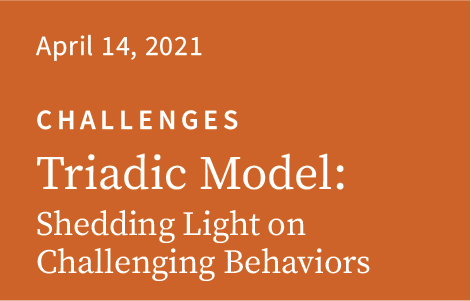Transcript
The Triadic Model: Shedding Light on Challenging Behaviors
If you care for someone with dementia, you’ve probably seen the individual change over time, and start to behave in ways that can be confusing or even distressing. They might wander, wake at night, seem agitated, or act aggressively. On the other hand, they may resist engaging in activities or experience distressing beliefs. These are just a few of many examples.
As clinicians, we know how troubling these behaviors can be, and we turn to a variety of models that help us shed light on them so we can help people to cope better. All models have merits, but the approach I’m going to describe is the one I often use. It’s called the Triadic Model, developed by Dr. Laura Gitlin and Dr. Mary Corcoran.
As the name implies, the Triadic Model suggests that the triggers or causes for dementia-related behaviors can be grouped into three different areas: the person with dementia, the caregiver, and the environment.
Let’s look a little more closely at each, starting with the person with dementia. We begin by asking, what’s happening within the person to possibly explain their behavior? Are they in pain or feeling uncomfortable—too hot or too cold—or experiencing medication side effects? Do they have an underlying medical condition, such as a urinary tract infection? How are they doing emotionally? Are they feeling a sense of loss of control? Are they under- or overstimulated, afraid, or confused about what to do?
Secondly, we explore the caregiver’s actions. We understand how difficult it can be to adjust to changes in the person with dementia. The way you always spoke with them may now inadvertently spark challenging behaviors. Some common triggers include using complex sentences or speaking quickly. Other examples might include under- or overestimating the person’s capabilities, rushing them, blaming them, yelling, not keeping a consistent routine, or even not making eye contact.
Finally, we look at the environment. Are the rooms too dark or bright, what’s the noise level, the temperature? Does the house lack stimulating activities, or is it cluttered and overstimulating?
Because the person with dementia can’t always articulate their unease—whether it originates within themselves, from the caregiver, or from the environment—they may express it through challenging behaviors.
There’s no better way to understand how the Triadic Model works, and why we are such advocates, than through example. Let’s look at a common behavioral challenge, agitation. Although each person displays agitation differently, in many of my clients it often seems to arise in the afternoon and early evening—as was the case with Louise, who became agitated around 4 pm. Louise, which is not her real name, would pace around, saying, “I want to go home,” and respond harshly when her family called her to dinner.
First we asked, what was going on within Louise that may have caused this behavior? She appeared confused and disoriented—she seemed to feel unsafe and insecure. It’s possible she didn’t recognize her family. Also, Louise typically moved her bowels after dinner, which would help reduce her agitation. It’s not often discussed, but the urgency for a bowel movement is a common trigger for agitation and aggressive behaviors. It’s also likely that Louise was tired after hours at adult day care.
Second, looking at the caregivers, we found that when she said she wanted to go home, they argued with her, saying, “You are home!” They tried to reason with her and explain why she needed to eat dinner.
Third, Louise’s environment seemed overstimulating. Upon returning home from the day program, she was met with multiple family members milling around the house, making dinner, and talking, and the television on in the background. The noise and commotion likely fed Louise’s agitation.
We made a number of adjustments. First, we set a toileting routine for as soon as Louise came home. We also suggested ways to reduce the stimulation: While the family made dinner, Louise rested quietly in the den, closing her eyes or listening to calm music. The caregivers also adapted their language, using comforting phrases to help Louise feel more secure, like “I know you want to go home. You’re safe,” and “I’m here with you.”
Louise greatly benefited from these changes. We were all happy to observe a significant decrease in her agitation.
Many caregivers can relate to the problem of their loved ones wandering into the street. Which was the case with Michael (not his real name), who would wander from the home while his wife, Lisa, worked in her home office.
Let’s look at what was happening within Michael. First, he might have been bored. While Lisa worked, Michael watched TV all day in his recliner. Maybe he got hungry or thirsty, or wanted to see his wife. Perhaps he needed to stretch his legs or use the bathroom. Michael would not have been able to express these needs. Also, Michael wasn’t used to being sedentary: He had been a security guard monitoring buildings, which involved a good deal of walking.
Looking at the second category, the caregiver’s actions, we found that Lisa’s communication was not a significant trigger for Michael’s wandering.
However, Michael’s environment did contribute to his wandering. His recliner faced the front door, a natural trigger for wandering. There were no locks or alerts on the door to let Lisa know when Michael opened it. Also, the environment lacked stimulation, so the door was his focus.
We addressed these issues one by one. We suggested that Michael use the bathroom regularly and made sure he was well fed and hydrated. We recommended regular exercise, as well as activities besides TV. To help him feel more secure, we suggested Lisa move her office to a place where Michael could see her and she could keep an eye on him. If that wasn’t possible, Lisa could employ a non-medical home care person to supervise and engage with Michael while she worked.
We offered a few strategies to address the environmental triggers. Michael’s recliner could be repositioned away from the front door, which could be camouflaged with a picture, or with a canvas to make it look like a bookshelf. A remote alarm could be installed to alert Lisa when the front door opened. Other safety measures could include using GPS trackers—there are GPS watches and shoe inserts, as well as toggles that can be sewn into a jacket or tied into shoelaces.
Finally, I’m thinking of a recent client, let’s call him Joe, who was being cared for by his wife, Mary. Whenever she told Joe it was time for a shower, or asked if he was ready for a shower, Joe answered with an emphatic “No.”
Looking at what was happening within Joe, we noted a few things: He felt cold, he seemed to feel a sense of loss of control, and he was afraid. But also he felt overwhelmed by having to shave and shower the same day.
Next let’s think about the caregiver. In this case it was the word “shower” and the way that Mary was presenting the activity by asking, “Joe, are you ready to shower?” that was a primary trigger for resistance. Mary had a very calm, kind tone of voice and did not rush Joe, so these were not contributing factors to resistance in this circumstance.
Lastly we can consider the physical environment. The bathroom was cold and the water usually wasn’t turned on until after Joe was in the bathroom, so it took time for the water to adjust to a comfortable warm temperature.
In Joe’s case, the strategies to address these issues were straightforward. We started by warming up the bathroom by running the hot water ahead of time. This removed the temperature barrier. This also gave Joe a cue that it was time to take a shower. Environmental cues like this can give the person with dementia a sense of control, and make them feel less resistant. We also considered Joe’s routine. Since Joe seemed overwhelmed by shaving and showering on the same day, we decided to alternate shaving and showering days to lower the level of stimulation.
By simply adjusting her phrasing to simple and generic words like “Come with me,” or “Let’s take a walk,” Mary could lead Joe to the warm shower without a struggle. The important component to consider is avoiding the trigger word or phrase; in this case, it was important for Mary to avoid the word “shower.”
I hope that I’ve given you a sense of how the Triadic Model can be used to bring more clarity to dementia-related behaviors. By helping to identify their possible causes or triggers, this model offers a starting point for creating strategies that will, hopefully, help improve the quality of life of people with dementia and their caregivers.
Rachel Wiley, MS, OTR/L, CDP
Occupational Therapist
Founder & Owner
Day By Day Home Therapy and the Dementia Collaborative

